While I was showing my Scotland book to a friend the other day, I was explaining that I was stitching a band as a wrap for my book, including all the highlights from our trip.
Eureka!
I have had this chart paper in my stash since the 90s and I finally drug it out yesterday to hand-chart this mystery orb.
I know some of you might use a computer program but I simply don't do enough cross stitch to justify the expense.
If you're like me, here's a great online source where you can print out your own graph paper.
Just choose the paper with the number of squares/inch that aligns with your fabric count and print it on transparent paper such as vellum.
I traced the design and then "squared" it in to give a semblance of the original shape. I did find that I needed to make some adjustments to my pattern as I stitched.
Tomorrow I'll explain why I've included this mystery ball on my piece...
I'll send a special surprise to the first person who can identify it in a comment below and tell me how you know it. If you have no idea, dont worry. I'll also send a surprise to the most creative wrong answer.
See you tomorrow.







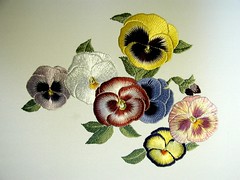
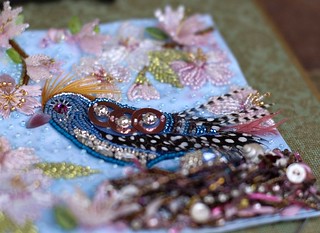
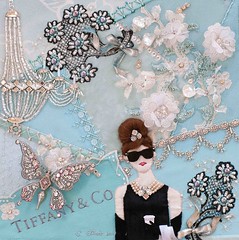
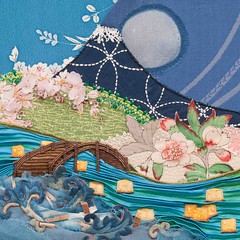
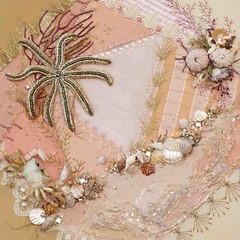












22 comments:
Is it the 'thingy' the monarch holds in his/her hand? ;O I do so enjoy your travels, even when you stay at home!
Does it represent the orb which appears on the Crown of Scotland? The Crown has four arches and where they meet there is an orb which is enamelled in blue with gilt stars....
Alison
Godalming, UK
Harris tweed has an orb symbol on it. I know this as my parents had a whole/retail fabric business. Also my dad used to get suits made and the tailor used to have bolts of Harris tweed. The tweed lengths are very narrow...about 27 inches and have a very distinctive smell from the process they use after weaving.
I believe it is called a Globus cruciger and is held in the hand of a royal person or ruler and represents God's or Christ's (the cross) dominion over the world (the globe part) and that power literally held in the hand of the ruler. Something that was curious to me when I saw it depicted years ago in several images when I took an art class in college and looked up.
It's very interesting...
Big hugs x
Ok, I'm going for the most creative wrong answer here. Is it Prince George's baby rattle turned upside down? Truthfully, I have no idea what it is, LOL.
It is not a mystery at all! Actually it is my family crest...oh wait, I am an Italian, not Scottish!
The first Scottish weather balloon?? ;)
It looks a lot like the orb used in the Coronation of Her Majesty Queen Elizabeth II...
It looks very familiar, and my first thought was that it was one of the swinging incense burners used in catholic churches, but I'm pretty sure I'm wrong about that.
Good Afternoon,
That is the Royal Orb that is used in Coronation Ceremonies. The Orb is held in the left hand and the Royal Scepter is held in the right hand, if I am not mistaken. British composer Edward Elgar, I believe, wrote a piece for one of the English Coronations and it is called "Orb and Scepter".
I love the history of Great Britain and one of these days will make that trip, to trace my Irish and Scottish family roots.
Thanks so much for all the glorious pictures!!
Pat Wafer
tigerbandpat@yahoo.com
Baton Rouge
Mary Ann got it ... the web is amazing I just googled Scotish Orb and one of the images was the Harris tweed Trademark.
Its the royal orb that is carried by the reigning monarch when they are crowned. currently in the tower of london.
The orb is a symbol representing the world. The fascinating thing is that it's divided into three parts because that was the "whole" world at the time of the symbol's creation (Europe, Asia, and Africa). It's often seen in Christ's (hence the cross on top) or other god's and sovereign's hands as a symbol of dominion. There is an excellent chapter on the symbol in the book "The Fourth Part of the World" by Toby Lester. How cool to see it rendered in cross stitch! Awesome blog, by the way!
Papal bowling ball!
Actually I just came to say that I *do* have cross-stitch charting software but I do my designs on graph paper anyway. It's just easier. Then if I want to share it I'll put it in the program to get a cleaned-up version.
Well, I don't have a clue, but it reminds me of the orb the Christ Child holds.
Papal bowling ball was good, but I doubt that our new Pope bowls ~lol~
Have a great weekend.
Gosh! Transparent graph paper! I need to find some of this....
Thanks for letting me know it exists.=)
It is a sovereign's orb, part of their coronation regalia
Not sure what the orb is...but I have some different size graphs that are printed onto a transparency ....you lay it over the picture and stitch away!
xo,
Deb
I believe this is some kind of Greek Orthdox spiritual orb that would be held in the hand during services. I have seen the Christchild holding something like this on a holy card.
Globus cruciger
From Wikimedia Commons, the free media repository
The globus cruciger (Latin) is an orb (globus) topped with a cross (cruciger), a Christian symbol of authority used throughout the Middle Ages on coins, iconography and royal regalia. It symbolises Christ's (the cross) dominion over the world (the orb), literally held in the dominion of an earthly ruler (or sometimes celestial being such as an angel). The first known use was in 423 on the reverse side of the coins of Emperor Theodosius II.
The globus cruciger was used by powerful rulers and celestial beings alike; it adorned portrayals of both emperors and archangels. It first appeared on coins in the early 5th century and remained popular throughout the Middle Ages in coins, iconography and royal regalia. Even in the modern era in England, the Sovereign's Orb symbolises both the state and Church (of England) under the protection and domain of the royal crown.
Loved reading all the answers ~ the bowling ball was classic!
Post a Comment